Conservation of two popular Fort Myers public artworks under way
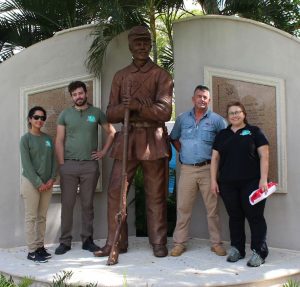 Work is finally underway in Centennial Park on two of Fort Myers’ popular public artworks. Several members of Rosa Lowinger & Associate’s crack conservation team have been in town since October 1 working on the USCT 2nd Regiment Monument in Centennial Park East and The Florida Panthers in the median on Monroe Street outside the entrance to the park and Harborside Event Center.
Work is finally underway in Centennial Park on two of Fort Myers’ popular public artworks. Several members of Rosa Lowinger & Associate’s crack conservation team have been in town since October 1 working on the USCT 2nd Regiment Monument in Centennial Park East and The Florida Panthers in the median on Monroe Street outside the entrance to the park and Harborside Event Center.
The USCT 2nd Regiment Monument depicts an African-American soldier. 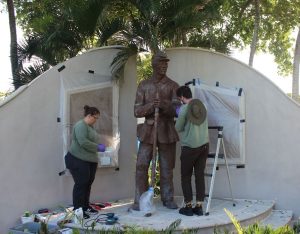 He symbolizes the black Union soldiers of Companies D & I who were stationed in Fort Myers in 1865. On February 20 of that year, they repelled an attack by the Florida Special Calvary 1st Battalion, known affectionately by ranchers from Punta Gorda to Tampa as the Cow Cavalry. The Cow Cavalry’s defeat in the Battle of Fort Myers is significant because had the Confederates succeeded, they would have undoubtedly burned
He symbolizes the black Union soldiers of Companies D & I who were stationed in Fort Myers in 1865. On February 20 of that year, they repelled an attack by the Florida Special Calvary 1st Battalion, known affectionately by ranchers from Punta Gorda to Tampa as the Cow Cavalry. The Cow Cavalry’s defeat in the Battle of Fort Myers is significant because had the Confederates succeeded, they would have undoubtedly burned 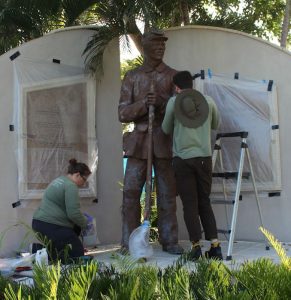 Fort Myers to the ground thereby precluding establishment of the eponymous town by Manual Gonzalez and his family, who converted buildings in the fort into their homes in the Spring of 1866.
Fort Myers to the ground thereby precluding establishment of the eponymous town by Manual Gonzalez and his family, who converted buildings in the fort into their homes in the Spring of 1866.
North Fort Myers sculptor Don D.J. Wilkins made the installation in 1998 at the behest of the Fort Myers Beautification Advisory Board. He nicknamed the sergeant depicted by the statue “Clayton,” because he used a ton of clay to cast the sculpture.
While the 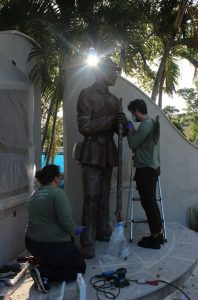 statue is structurally sound, it suffers from significant paint loss due to 20 years of wind, rain, intense sunlight and heat. So the conservators have removed the dirt, grime and soluble salts from the surface and are now carefully stripping off the paint one layer at a time. Once that step has been completed, they’ll inject a special conservation-grade epoxy into the handful of cracks that have developed in the statue and then they’ll repaint Clayton with an industrial paint that provides maximum protection in a marine environment.
statue is structurally sound, it suffers from significant paint loss due to 20 years of wind, rain, intense sunlight and heat. So the conservators have removed the dirt, grime and soluble salts from the surface and are now carefully stripping off the paint one layer at a time. Once that step has been completed, they’ll inject a special conservation-grade epoxy into the handful of cracks that have developed in the statue and then they’ll repaint Clayton with an industrial paint that provides maximum protection in a marine environment.
“It’s designed for water parks and water tanks,” notes lead RLA conservator Lucinda Linderman.
Beyond the 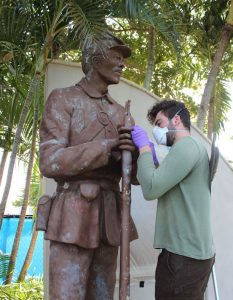 high humidity and heavy summer rainfall associated with our subtropical climate, Clayton is subjected to a constant barrage of water particles and even sea salt carried by the wind from the river and the Gulf of Mexico some 14 miles away. The paint RLA is using on the statue will seal the underlying composite from the elements. But it comes with a pretty hefty price tag of nearly $500 per gallon.
high humidity and heavy summer rainfall associated with our subtropical climate, Clayton is subjected to a constant barrage of water particles and even sea salt carried by the wind from the river and the Gulf of Mexico some 14 miles away. The paint RLA is using on the statue will seal the underlying composite from the elements. But it comes with a pretty hefty price tag of nearly $500 per gallon.
“With annual cleaning and periodic maintenance, the installation can last a very long time,” Linderman says. The paint has one of the best useful lives available on the market today.
One of 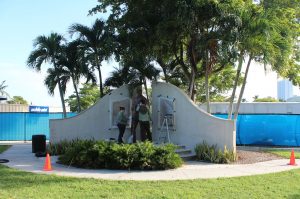 the walls behind the soldier was damaged by falling limbs during Hurricane Irma in September of 2017. That damage is being repaired by local contractor Chris-Tel Construction, who will also pressure wash the wall, steps and landing, patch and point the decking and repaint the wall and risers.
the walls behind the soldier was damaged by falling limbs during Hurricane Irma in September of 2017. That damage is being repaired by local contractor Chris-Tel Construction, who will also pressure wash the wall, steps and landing, patch and point the decking and repaint the wall and risers.
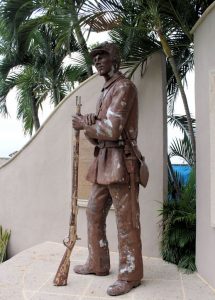 RLA and Chris-Tel expect to complete all of this work well in advance of Veteran’s Day, which will mark the 20th anniversary of the USCT 2nd Regiment’s dedication in 1998. At least one local organization, Showing Up for Racial Justice, is planning to observe the occasion with a re-dedication ceremony.
RLA and Chris-Tel expect to complete all of this work well in advance of Veteran’s Day, which will mark the 20th anniversary of the USCT 2nd Regiment’s dedication in 1998. At least one local organization, Showing Up for Racial Justice, is planning to observe the occasion with a re-dedication ceremony.
In contrast to Clayton, The Florida Panthers require a bit more attention and care.
This piece consists of three panthers positioned on top of the walls of off-setting reflection pools in the median of Monroe Street. A male prowls the northern reflection pool; a female and her cub recline on the walls of the 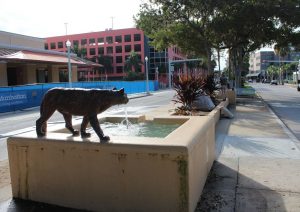 second water feature. There was once also a frog positioned next to the cub, but that piece disappeared a few years ago.
second water feature. There was once also a frog positioned next to the cub, but that piece disappeared a few years ago.
The challenge associated with the three panthers is the fact that Wilkins used rebar in the tail, legs and ears of the big cats in order to stabilize them and repair damage caused by pedestrians over time. Limbs and other wind-blown debris during Hurricane Irma 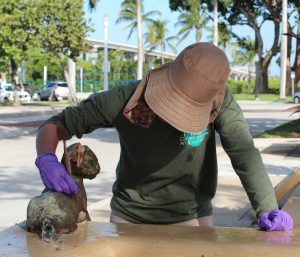 took bites out of the castings, including much of the male’s tale and part of the cub’s head. And protecting the panthers from the elements is even more challenging that with Clayton since the bubblers in the reflection pools splash chlorinated water on the sculptures 24/7.
took bites out of the castings, including much of the male’s tale and part of the cub’s head. And protecting the panthers from the elements is even more challenging that with Clayton since the bubblers in the reflection pools splash chlorinated water on the sculptures 24/7.
But RLA has a conservation plan designed to restore the three cats to their original grandeur and protect the sculptures from damage and exposure to the elements in the future.
“In 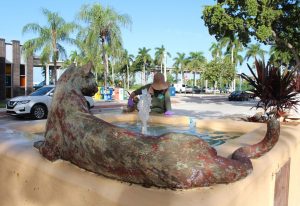 concert with the artist, we’re going to recast and reposition the male’s tale so that it’s less susceptible to breakage,” Linderman reports.
concert with the artist, we’re going to recast and reposition the male’s tale so that it’s less susceptible to breakage,” Linderman reports.
The conservators will also employ special measures to protect the cats from corrosion, fractures and spalling.
Once RLA has completed its end of the work on 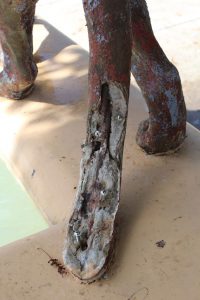 The Florida Panthers, Chris-Tel will make upgrades to the plumbing and repair, reseal and repaint the walls of both pool, which have been weeping over the past couple of years.
The Florida Panthers, Chris-Tel will make upgrades to the plumbing and repair, reseal and repaint the walls of both pool, which have been weeping over the past couple of years.
Because of the scope of the work involved and the need to cast an entirely new frog, it will take several few weeks longer to complete conservation of this artwork, which pays homage to Florida’s state animal, which has been on the federal endangered species list since 1967 and the Florida endangered species list since 1973. In fact, a recent survey conducted by the Florida Fish and Wildlife Conservation Commission last year, there may be as few as 100 Florida Panthers still living in the wild.
Over 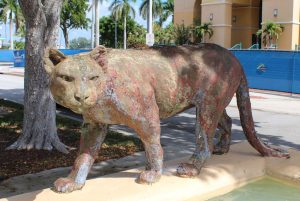 the course of the next several months, Rosa Lowinger & Associates and Chris-Tel Construction will also be conserving Uncommon Friends, The Great Turtle Chase, the Buckingham & Paige Army Air Field Memorial and the Wes Nott Monument. The current conservation effort is an extension of work begun last year with the repair and renovation of The Spirit of Fort Myers (nicknamed Rachel at the Well).
the course of the next several months, Rosa Lowinger & Associates and Chris-Tel Construction will also be conserving Uncommon Friends, The Great Turtle Chase, the Buckingham & Paige Army Air Field Memorial and the Wes Nott Monument. The current conservation effort is an extension of work begun last year with the repair and renovation of The Spirit of Fort Myers (nicknamed Rachel at the Well).
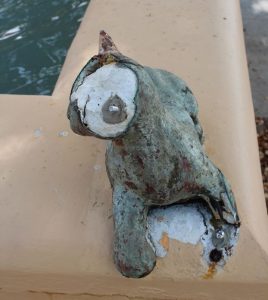 And as work on these pieces is completed, text, photos and audio recordings providing behind-the-scenes stories and information will be added to Otocast, a free phone app the City’s Public Art Committee is making available to residents, visitors, vacationers and heritage tourists so that they can fully appreciate and enjoy Fort Myers’ public art collection.
And as work on these pieces is completed, text, photos and audio recordings providing behind-the-scenes stories and information will be added to Otocast, a free phone app the City’s Public Art Committee is making available to residents, visitors, vacationers and heritage tourists so that they can fully appreciate and enjoy Fort Myers’ public art collection.
Rosa Lowinger & Associates specializes in the conservation of built heritage, a term that encompasses art, architecture, museum collections, and public spaces. Rosa Lowinger is a recognized international expert in conservation and a specialist in modern 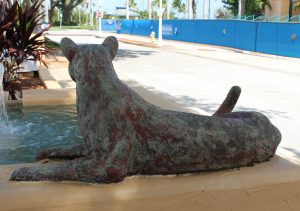 and contemporary sculpture, architecture, and public art. She has been in private practice since 1988. Each of the company’s senior staff has been in practice for no less than 5 years and as a team, RLA has a combination of 50 years of experience carrying out conservation, cultural resource documentation, restoration, and historic remediation projects
and contemporary sculpture, architecture, and public art. She has been in private practice since 1988. Each of the company’s senior staff has been in practice for no less than 5 years and as a team, RLA has a combination of 50 years of experience carrying out conservation, cultural resource documentation, restoration, and historic remediation projects 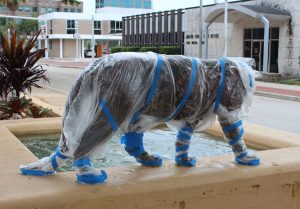 for architecture, public art, and sculpture in stone, masonry, concrete, metals, ceramic tile, terracotta, wood, plastic, plaster, terrazzo, linoleum and mosaics.
for architecture, public art, and sculpture in stone, masonry, concrete, metals, ceramic tile, terracotta, wood, plastic, plaster, terrazzo, linoleum and mosaics.
Clients include the Hawaii State Foundation for Culture and the Arts and the cities of Los Angeles, San Jose, Ventura, Santa Monica, Inglewood, Santa Fe Springs, and Honolulu. Rosa lectures and publishes 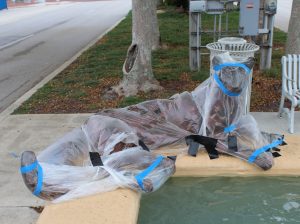 frequently on conservation topics related to modern and contemporary sculpture and architecture (see My Writings), and in 2009 was awarded the prestigious Rome Prize in Conservation at the American Academy in Rome for research into the history of vandalism. She is the author of Tropicana Nights: The Life and Times of the Legendary Cuban Nightclub and a founding contributor
frequently on conservation topics related to modern and contemporary sculpture and architecture (see My Writings), and in 2009 was awarded the prestigious Rome Prize in Conservation at the American Academy in Rome for research into the history of vandalism. She is the author of Tropicana Nights: The Life and Times of the Legendary Cuban Nightclub and a founding contributor 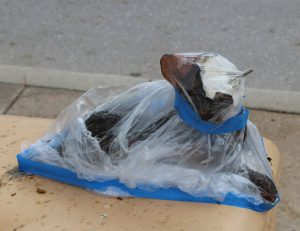 to the award-winning art-and-culture blog C-Monster.net. Rosa is particularly passionate about maintenance of the built heritage of Cuba, her country of birth, and actively seeks to promote international interest in its preservation. She has an M.A. in art history and conservation from New York University’s Institute of Fine Arts in 1982.
to the award-winning art-and-culture blog C-Monster.net. Rosa is particularly passionate about maintenance of the built heritage of Cuba, her country of birth, and actively seeks to promote international interest in its preservation. She has an M.A. in art history and conservation from New York University’s Institute of Fine Arts in 1982.
October 9, 2018.














 Tom Hall is both an amateur artist and aspiring novelist who writes art quest thrillers. He is in the final stages of completing his debut novel titled "Art Detective," a story that fictionalizes the discovery of the fabled billion-dollar Impressionist collection of Parisian art dealer Josse Bernheim-Jeune, thought by many to have perished during World War II when the collection's hiding place, Castle de Rastignac in southern France, was destroyed by the Wehrmacht in reprisal for attacks made by members of the Resistance operating in the area. A former tax attorney, Tom holds a bachelor's degree as well as both a juris doctorate and masters of laws in taxation from the University of Florida. Tom lives in Estero, Florida with his fiancee, Connie, and their four cats.
Tom Hall is both an amateur artist and aspiring novelist who writes art quest thrillers. He is in the final stages of completing his debut novel titled "Art Detective," a story that fictionalizes the discovery of the fabled billion-dollar Impressionist collection of Parisian art dealer Josse Bernheim-Jeune, thought by many to have perished during World War II when the collection's hiding place, Castle de Rastignac in southern France, was destroyed by the Wehrmacht in reprisal for attacks made by members of the Resistance operating in the area. A former tax attorney, Tom holds a bachelor's degree as well as both a juris doctorate and masters of laws in taxation from the University of Florida. Tom lives in Estero, Florida with his fiancee, Connie, and their four cats.